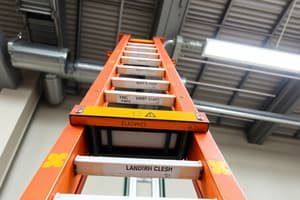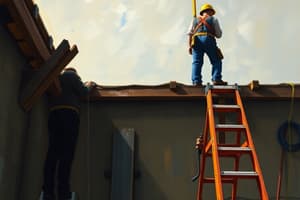Podcast
Questions and Answers
What is the primary consideration when selecting a ladder for a job?
What is the primary consideration when selecting a ladder for a job?
- The price and warranty of the ladder
- The brand and model of the ladder
- The weight capacity, height, and material (correct)
- The color and aesthetic appeal of the ladder
What is a common hazard to identify when using ladders?
What is a common hazard to identify when using ladders?
- The ladder's brand logo
- The ladder's weight
- Overreaching or leaning to the side (correct)
- The ladder's color scheme
What is a recommended practice for fall prevention when using ladders?
What is a recommended practice for fall prevention when using ladders?
- Facing away from the ladder when ascending
- Wearing a harness
- Holding onto someone for support
- Maintaining three points of contact (correct)
According to OSHA regulations, what must be clearly marked on a ladder?
According to OSHA regulations, what must be clearly marked on a ladder?
What is a requirement for ladder rungs according to OSHA regulations?
What is a requirement for ladder rungs according to OSHA regulations?
What should you do when inspecting a ladder before use?
What should you do when inspecting a ladder before use?
What environmental factor can affect ladder safety?
What environmental factor can affect ladder safety?
What is a recommended accessory for ladder safety?
What is a recommended accessory for ladder safety?
Flashcards are hidden until you start studying
Study Notes
Ladder Safety
Ladder Selection
- Choose the right ladder for the job:
- Consider the weight capacity, height, and material
- Select a ladder that is suitable for the task and environmental conditions
- Inspect the ladder before use:
- Check for damage, wear, and tear
- Ensure all rungs are secure and level
- Verify that the ladder is properly labeled and rated
Hazard Identification
- Identify potential hazards:
- Slippery or uneven surfaces
- Overreaching or leaning to the side
- Incorrect ladder placement or angle
- Electrical or other hazards in the surrounding area
- Be aware of environmental factors:
- Weather conditions (e.g. wind, rain, ice)
- Poor lighting or visibility
Fall Prevention
- Always maintain three points of contact:
- Two hands and one foot, or two feet and one hand
- Face the ladder when ascending or descending:
- Avoid twisting or turning on the ladder
- Use ladder safety accessories:
- Leveling devices or stabilizers
- Anti-slip feet or ladder mats
OSHA Regulations
- General requirements:
- Ladders must be able to support the weight of the user and any materials
- Ladders must be maintained in good condition
- Specific regulations:
- Ladder rungs must be evenly spaced and securely attached
- Ladder feet must be slip-resistant
- Ladders must be used on a firm, level surface
- Maximum weight capacity must be clearly marked on the ladder
Ladder Safety
Ladder Selection
- Consider weight capacity, height, and material when choosing a ladder for the job
- Ensure the ladder is suitable for the task and environmental conditions
- Inspect the ladder before use, checking for damage, wear, and tear
- Verify all rungs are secure and level, and the ladder is properly labeled and rated
Hazard Identification
- Slippery or uneven surfaces are potential hazards
- Overreaching or leaning to the side can lead to accidents
- Incorrect ladder placement or angle can cause falls
- Electrical or other hazards in the surrounding area must be considered
- Weather conditions (e.g. wind, rain, ice) affect ladder safety
- Poor lighting or visibility can increase the risk of accidents
Fall Prevention
- Maintain three points of contact with the ladder: two hands and one foot, or two feet and one hand
- Face the ladder when ascending or descending to avoid twisting or turning
- Use ladder safety accessories: leveling devices, stabilizers, anti-slip feet, or ladder mats
- Ensure hands are free of gloves or other objects that may affect grip
OSHA Regulations
- Ladders must support the weight of the user and any materials
- Ladders must be maintained in good condition
- Rungs must be evenly spaced and securely attached
- Ladder feet must be slip-resistant
- Ladders must be used on a firm, level surface
- Maximum weight capacity must be clearly marked on the ladder
Studying That Suits You
Use AI to generate personalized quizzes and flashcards to suit your learning preferences.




